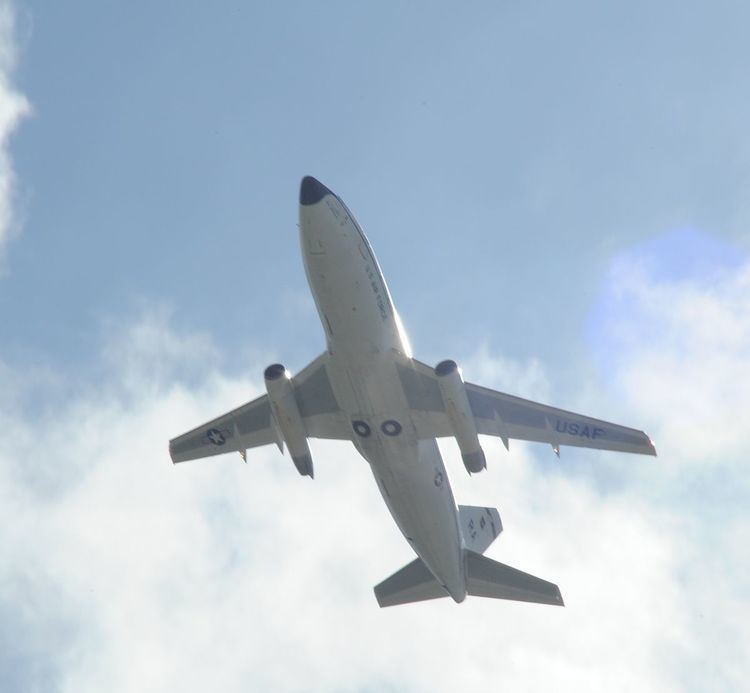The 453d Electronic Warfare Squadron is a United States Air Force unit. It is assigned to the 53d Wing and is stationed at Lackland Air Force Base, Texas.
The 453d EWS provides a full spectrum of EW support to DoD and coalition warfighters. The 453 EWS provides EW support through four flights, operating together to create a foundation of EW knowledge, maintain and update such knowledge, provide in-depth radio frequency and other electronic warfare analyses and create a realistic training environment for the warfighter. The 453 EWS products and services are utilized in a variety of areas, including mission planning, training, and exercises.
The Flagging Analysis flight, (EWF), provides a 24/7 tactical comparison of "current expectations" to current reality to ensure the warfighter is prepared to deploy and operate effectively. Tactical monitoring of the worldwide threat environment is crucial to the detection and identification of new or changed threat radars that may impact the performance of aircraft EW systems. Flagging analysis provides the detection of anomalous threat operation and provides the trigger to energize the EWIR community.The Operations flight, (EWO) provides analyses of EW & C3ISR systems' performance in support of operational, acquisition, and training activities. The Improved Many-on-Many (IMOM) family of analysis tools are the most prominent part of the flight, supporting mission planners with comprehensive EW/C3ISR analyses, including radar detection, threat engagement, communications jamming, ISR collection, PSYOP broadcast, and passive detection capabilities. The flight also provides the constructive EW environment used in generating country-specific opposing force integrated air defense system threats. Additionally, the flight provides constructive (computer-based) EW target sets and various other modeling and simulation-based training scenarios to meet a wide range of warfighter training objectives. The DMO approach to training provides flexibility with respect to scenario generation and realism. The inherent flexibility of DMO allows for endless potential with respect to integration across the entire Live, Virtual, and Constructive training spectrum.In 2015, The Data flight became a part of the 57 Intel Squadron. It provides the foundation of EW knowledge used by mission planners and the acquisition community through the development and maintenance of the Combat Support Database (CSDB), Blue Airborne Target Signatures (BATS) Database, US Electromagnetic Systems Database (USELMS), Commercial Emitter Database, and the Next-Generation Electronic Warfare Integrated Reprogramming (EWIR) Database.In June 2016, elements of the 68th Electronic Warfare Squadron became 'Detachment 1, 453 EWS'.The 453 EWS continues to build key partnerships to provide comprehensive EW support to the joint warfighter community as well as coalition partner countries such as the United Kingdom, Canada and Australia.Formed under III Bomber Command in early 1943 as a B-26 Marauder medium bomber squadron. Trained for duty in Europe with Ninth Air Force. Engaged in combat beginning in early 1944, attacked tactical targets in France, Low Countries and Germany supporting Allied ground forces advancing after D-Day in Northern France Campaign and the Western Allied invasion of Germany, 1945. Earned a Presidential Unit Citation for actions on 24 December 1944 through 27 December 1944, during the Battle of the Bulge, when squadron effectively attacked transportation installations used by enemy forces to bring reinforcements to the Ardennes. Served in the Army of Occupation involved with disarming the Luftwaffe. Received A-26 Invaders in April 1945, however did not use in combat. Returned to the United States for inactivation.Trained as a reserve unit, and personnel used as fillers when activated for the Korean War 1949–1951. Probably assigned AT-6, AT-7, and AT-11 trainers for aircrew proficiency flying, but not an operational unit.As the 453 FTS at Mather AFB (Sacramento, CA), Trained electronic warfare officers 1973–1993Is the fusion of the core EW functions from the original AF EW Center (AFEWC)Traces its lineage to the AF Special Communications (AFSPECCOM) Center of Excellence's EW Effectiveness Analysis MissionConstituted as the 453d Bombardment Squadron (Medium) on 19 June 1942Activated on 4 August 1942Redesignated
453d Bombardment Squadron, Medium c. 9 October 1944Inactivated on 14 December 1945Redesignated
453d Bombardment Squadron, Light on 10 May 1949Activated in the reserve on 27 June 1949Ordered to active service on 10 March 1951Inactivated on 17 March 1951Redesignated
453d Fighter-Bomber Squadron on 9 May 1955Activated on 8 August 1955Inactivated on 1 September 1957Redesignated
453d Flying Training Squadron c. 28 July 1972Activated on 1 April 1973Inactivated on 31 May 1993Redesignated
453d Electronic Warfare SquadronActivated c. 2000
323d Bombardment Group, 4 August 1942 – 12 December 1945323d Bombardment Group, 27 June 1949 – 17 March 1951323d Fighter-Bomber Group, 8 August 1955 – 1 September 1957323rd Flying Training Wing, 1 April 1973 – 15 December 1991323d Operations Group, 15 December 1991 – 31 May 1993318th Information Operations Group, c. May 2000 – 5 August 200953d Electronic Warfare Group, 5 Aug 2009 –Martin B-26 Marauder 1942–1945North American F-86 Sabre 1956North American F-100 Super Sabre 1956–1957Convair T-29 1973–1975Boeing T-43 1975–1993
